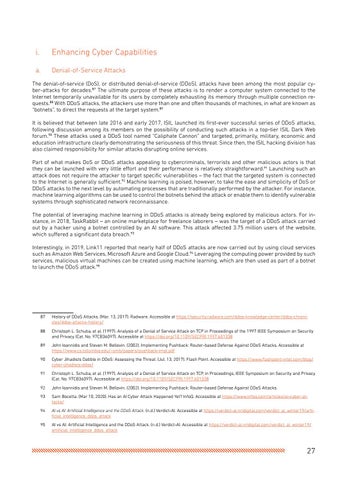i.
Enhancing Cyber Capabilities
a.
Denial-of-Service Attacks
The denial-of-service (DoS), or distributed denial-of-service (DDoS), attacks have been among the most popular cyber-attacks for decades.87 The ultimate purpose of these attacks is to render a computer system connected to the Internet temporarily unavailable for its users by completely exhausting its memory through multiple connection requests.88 With DDoS attacks, the attackers use more than one and often thousands of machines, in what are known as “botnets”, to direct the requests at the target system.89 It is believed that between late 2016 and early 2017, ISIL launched its first-ever successful series of DDoS attacks, following discussion among its members on the possibility of conducting such attacks in a top-tier ISIL Dark Web forum.90 These attacks used a DDoS tool named “Caliphate Cannon” and targeted, primarily, military, economic and education infrastructure clearly demonstrating the seriousness of this threat. Since then, the ISIL hacking division has also claimed responsibility for similar attacks disrupting online services. Part of what makes DoS or DDoS attacks appealing to cybercriminals, terrorists and other malicious actors is that they can be launched with very little effort and their performance is relatively straightforward.91 Launching such an attack does not require the attacker to target specific vulnerabilities – the fact that the targeted system is connected to the Internet is generally sufficient.92 Machine learning is poised, however, to take the ease and simplicity of DoS or DDoS attacks to the next level by automating processes that are traditionally performed by the attacker. For instance, machine learning algorithms can be used to control the botnets behind the attack or enable them to identify vulnerable systems through sophisticated network reconnaissance. The potential of leveraging machine learning in DDoS attacks is already being explored by malicious actors. For instance, in 2018, TaskRabbit – an online marketplace for freelance laborers – was the target of a DDoS attack carried out by a hacker using a botnet controlled by an AI software. This attack affected 3.75 million users of the website, which suffered a significant data breach.93 Interestingly, in 2019, Link11 reported that nearly half of DDoS attacks are now carried out by using cloud services such as Amazon Web Services, Microsoft Azure and Google Cloud.94 Leveraging the computing power provided by such services, malicious virtual machines can be created using machine learning, which are then used as part of a botnet to launch the DDoS attack.95
87
History of DDoS Attacks. (Mar. 13, 2017). Radware. Accessible at https://security.radware.com/ddos-knowledge-center/ddos-chronicles/ddos-attacks-history/
88
Christoph L. Schuba, et al. (1997). Analysis of a Denial of Service Attack on TCP in Proceedings of the 1997 IEEE Symposium on Security and Privacy (Cat. No. 97CB36097). Accessible at https://doi.org/10.1109/SECPRI.1997.601338
89
John Ioannidis and Steven M. Bellovin. (2002). Implementing Pushback: Router-based Defense Against DDoS Attacks. Accessible at https://www.cs.columbia.edu/~smb/papers/pushback-impl.pdf
90
Cyber Jihadists Dabble in DDoS: Assessing the Threat. (Jul. 13, 2017). Flash Point. Accessible at https://www.flashpoint-intel.com/blog/ cyber-jihadists-ddos/
91
Christoph L. Schuba, et al. (1997). Analysis of a Denial of Service Attack on TCP, in Proceedings, IEEE Symposium on Security and Privacy (Cat. No. 97CB36097). Accessible at https://doi.org/10.1109/SECPRI.1997.601338
92
John Ioannidis and Steven M. Bellovin. (2002). Implementing Pushback: Router-based Defense Against DDoS Attacks.
93
Sam Bocetta. (Mar 10, 2020). Has an AI Cyber Attack Happened Yet? InfoQ. Accessible at https://www.infoq.com/articles/ai-cyber-attacks/
94
AI vs AI: Artificial Intelligence and the DDoS Attack. (n.d.) Verdict-AI. Accessible at https://verdict-ai.nridigital.com/verdict_ai_winter19/artificial_intelligence_ddos_attack
95
AI vs AI: Artificial Intelligence and the DDoS Attack. (n.d.) Verdict-AI. Accessible at https://verdict-ai.nridigital.com/verdict_ai_winter19/ artificial_intelligence_ddos_attack
27












